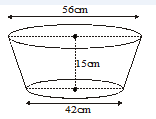10th Grade > Mathematics > Area
SURFACE AREAS AND VOLUMES MCQs
:
B
This leaves only the following surfaces for the combined solid-
1. One flat surface of coin
2. Curved surface of coin
3. Curved surface area of cone
These 3 areas add up together to give total surface area of combined solid.
:
B
The total surface area of the tent:
T=2πrh1+πrlπ=227;r=2.1 mh1=height of the cylinder=4 mh2=height of the cone=2.8 ml= slant height of the conel=√2.82+2.12=3.5 m
So,
T=(2×227×2.1×4+227×2.1×3.5)T=75.9 m2
Therefore, the total cost of canvas at ₹100 per sq meter = 75.9×100=₹ 7590.
:
A
If any solid is reshaped into a new solid then volume always remains constant.
:
B
In one minute 192.5 litres of water flows.
So, The Volume of water that flows in one hour = (192.50 × 60) liters. [∵1 hour=60 mins ]
Volume in cm3 = (192.5 × 60 × 1000) cm3 [∵1 litre=1000 cm3 ]
Inner radius of the pipe = 3.5 cm.
Let the length of column of water that flows in 1 hour be h cm.
Then,227 × 3.5 × 3.5 × h = 192.5 × 60 × 1000
h= 300000 cm = 3 km
Hence, the rate of flow = 3 km per hour.
:
B
Given
r = 7m
h = 1m
Surface area of hemisphere = 2πr2
=2×227×(7)2 = 308 m2.
For calculating the surface area of a cone we need to calculate its slant height,
l = √r2+h2
l = √49+1=√50 m.
Surface area of cone = πrl= 227×7×√50 = 155.39 m2.
So, area of cloth required = (308 + 155.39)m2 = 463.39 m2
:
C
Given, Radius of Cylinder, r=7 m
length of roller, h=2 m
Width of road, B=2 m
Length of road be ′L′
Number of revolution taken = 25
Roller rolls on its curved surface area.
∴ Surface area of = CSA of cylinder
one revolution
=2πrh=2×227×7×2=88 m2
Total area covered in 25 revolution =25×88=2200 m2
This area will be equal to the area of the road levelled
Area of road = L×B=2200⇒L×2=2200⇒L=1100 m
∴ Length of the level road is 1100 m.
A vessel is in the form of an inverted cone. Its height is 8 cm and the radius of its top, which is open, is 5 cm. It is filled with water up to the brim. When lead shots, each of which is a sphere of radius 0.5 cm are dropped into the vessel, one-fourth of the water flows out. The number of lead shots dropped in the vessel is ______.
:
A
Let number of lead shots = n
Height of cone =h=8 cm
Radius of cone =r1=5 cm
Volume of water present in the cone = Volume of cone =13.π.(r1)2.h
=(13×227×52×8 cm2)
Volume of water flown out =(14×13×227×52×8) cm3
Radius of lead shot =r=0.5 cm
Volume of each lead shot ... =43.π.r3=(43×227×(0.5)3) cm3
According to given situation, n lead shots are thrown into cone such that 1/4th of water present in cone flows out.
It means volume of n lead shots = volume of water flown out
⇒ (n×43×227×(0.5)3)=(14×13×227×52×8)
⇒ n=14×13×52×8×1(0.53)×34
⇒ n=100



















